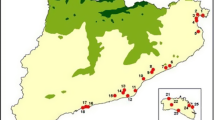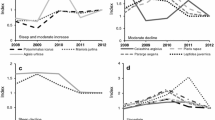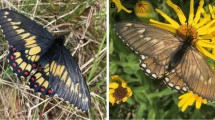Abstract
The Glanville fritillary is one of Britain’s rarest breeding butterflies, and is predominantly restricted to the south coast of the Isle of Wight. Populations have been monitored annually at a high proportion of known sites by counting the number of larval ‘webs’ during spring since 1996. In this paper, we present population time series for eight core sites. Populations have been observed to fluctuate considerably over the last 18 years, with a high degree of synchrony between sites. Recently, numbers of larval webs have shown a severe decline, with simultaneous extinctions occurring across many former strongholds. We combine our web count data with counts of adult butterflies from five sites of the UK Butterfly Monitoring Scheme. Together, these data suggest that the Glanville fritillary is threatened by extinction on the Isle of Wight, and that the total area used for breeding is likely no more than a few km2. The results flag up the need for a national census of remaining populations and further research to understand causes of decline, so that a conservation recovery plan can be developed.




Similar content being viewed by others
References
Andrewartha HG, Birch LC (1954) Distribution and abundance of animals. University of Chicago Press, Chicago
Asher J, Warren M, Fox R, Harding P, Jeffcoate G, Jeffcoate S (2001) The millennium atlas of butterflies in Britain and Ireland. Oxford University Press, Oxford
Begon R, Harper JL, Townsend CR (1986) Ecology—individuals, populations and communities. Blackwell, Oxford
Botham MS, Brereton TM, Middlebrook I, Cruickshanks KL, Zannese A, Roy DB (2009) United Kingdom butterfly monitoring scheme report for 2009. CEH, Wallingford
Brown JH (1984) The relationship between abundance and distribution of species. Am Nat 124:255–279
Bryant SR, Thomas CD, Bale JS (2000) Thermal ecology of gregarious and solitary nettle-feeding nymphalid butterfly larvae. Oecologia 122:1–10
Bryant SR, Thomas CD, Bale JS (2002) The influence of thermal ecology on the distribution of three nymphalid butterflies. J Appl Ecol 39:43–55
Caughley G (1994) Directions in conservation biology. J Anim Ecol 63:215–244
Curtis RJ, Isaac NJB (2014) The effect of temperature and habitat quality on abundance of the Glanville fritillary on the Isle of Wight; implications for conservation management in a warming climate. J Insect Conserv. doi:10.1007/s10841-014-9738-1
Davies ZG, Wilson RJ, Coles S, Thomas CD (2006) Changing habitat associations of a thermally constrained species, the silver-spotted skipper butterfly, in response to climate warming. J Anim Ecol 75:247–256
Dennis RLH (2010) A resource-based habitat view for conservation: butterflies in the British landscape. Wiley, Chichester
Diamond SE, Frame AM, Martin RA, Buckley LB (2011) Species’ traits predict phenological responses to climate change in butterflies. Ecology 92:1005–1012
Ehrlich PR (1983) Genetics and the extinction of butterfly populations. In: Schonewald Cox CM, Chambers SM, MacBryde B, Thomas WL (eds) Genetics and conservation. A reference for managing wild animal and plant populations. Benjamin/Cummings Publishing Company, California
Erhardt A, Thomas JA (1991) Lepidoptera as indicators of change in semi-natural grasslands of lowland and upland Europe. In: Collins NM, Thomas JA (eds) The conservation of insects and their habitats. Academic Press, London, pp 213–236
Ford EB (1945) Butterflies. Collins, London
Hanski I (1994) A practical model of metapopulation dynamics. J Anim Ecol 63:151–162
Hanski I (1998) Metapopulation dynamics. Nature 396:41–49
Hanski I (1999) Metapopulation ecology. Oxford University Press, Oxford
Hanski I, Meyke E (2005) Large-scale dynamics of the Glanville fritillary butterfly: landscape structure, population processes, and weather. Ann Zool Fenn 42:379–395
Johst K, Drechsler M, van Teeffelen AJA, Hartig F, Vos CC, Wissel S, Waetzold F, Opdam P (2011) Biodiversity conservation in dynamic landscapes: trade-offs between number, connectivity and turnover of habitat patches. J Appl Ecol 48:1227–1235
Jones JPG (2011) Monitoring species abundance and distribution at the landscape scale. J Appl Ecol 48:9–13
Krebs CJ (1978) Ecology: the experimental analysis of distribution and abundance. Harper & Row, New York
Leidner AK, Haddad NM (2011) Combining measures of dispersal to identify conservation strategies in fragmented landscapes. Conserv Biol 25:1022–1031
MacArthur R (1984) Geographical ecology: patterns in the distribution of species. Princeton University Press, Princeton
Mattila N, Kaitala V, Komonen A, PÄIvinen J, Kotiaho JS (2011) Ecological correlates of distribution change and range shift in butterflies. Insect Conserv Divers 4:239–246
May RM (1975) Patterns of species abundance and diversity. In: Cody MLD, Diamond JM (eds) Ecology and evolution of communities. The Belknap Press of Harvard University Press, Cambridge, pp 81–120
McGill BJ (2006) A renaissance in the study of abundance. Science 314:770–772
Ojanen SP, Nieminen M, Meyke E, Pöyry J, Hanski I (2013) Long-term metapopulation study of the Glanville fritillary butterfly (Melitaea cinxia): survey methods, data management, and long-term population trends. Ecol Evol 3:3713–3737
Oliver TH, Roy DB, Brereton T, Thomas JA (2012) Reduced variability in range-edge butterfly populations over three decades of climate warming. Glob Change Biol 18:1531–1539
Oostermeijer JGB, van Swaay CAM (1998) The relationship between butterflies and environmental indicator values: a tool for conservation in a changing landscape. Biol Conserv 86:271–280
Pollard E, Yates TJ (1993) Monitoring butterflies for ecology and conservation. Chapman and Hall, London
Porter K (1982) Basking behaviour in larvae of the butterfly Euphydryas aurinia. Oikos 38:308–312
Ross JV, Sirl DJ, Pollett PK, Possingham HP (2008) Metapopulation persistence in a dynamic landscape: more habitat or better stewardship? Ecol Appl 18:590–598
Roy DB, Rothery P, Brereton T (2007) Reduced-effort schemes for monitoring butterfly populations. J Appl Ecol 44:993–1000
Simcox DJ, Thomas JA (1979) The Glanville fritillary survey 1979. In: Unpublished report to the Joint Committee for the Conservation of British Insects. Furzebrook, Dorset
Storch D, Gaston KJ (2004) Untangling ecological complexity on different scales of space and time. Basic Appl Ecol 5:389–400
Thomas JA (1991) Rare species conservation: case studies of European butterflies. In: Spellerberg IF, Goldsmith FB, Morris MG (eds) The scientific management of temperate communities for conservation. Blackwell, Oxford, pp 149–197
Thomas JA (1993) Holocene climate changes and warm man-made refugia may explain why a 6th of British butterflies possess unnatural early-successional habitats. Ecography 16:278–284
Thomas JA (1995) Why small cold-blooded insects pose different conservation problems to birds in modern landscapes. Ibis 137:S112–S119
Thomas JA, Lewington R (2010) The butterflies of Britain & Ireland. British Wildlife Pub, Gillingham
Thomas JA, Simcox DJ (1982) A quick method for estimating larval populations of Melitaea cinxia L. during surveys. Biol Conserv 22:315–322
Thomas JA, Moss D, Pollard E (1994) Increased fluctuations of butterfly populations towards the northern edges of species ranges. Ecography 17:215–220
Thomas JA, Bourn NAD, Clarke RT, Stewart KE, Simcox DJ, Pearman GS, Curtis R, Goodger B (2001) The quality and isolation of habitat patches both determine where butterflies persist in fragmented landscapes. Proc R Soc Lond Ser B Biol Sci 268:1791–1796
Thomas JA, Telfer MG, Roy DB, Preston CD, Greenwood JJD, Asher J, Fox R, Clarke RT, Lawton JH (2004) Comparative losses of British butterflies, birds, and plants and the global extinction crisis. Science 303:1879–1881
UKBMS (2013) Mottistone down: counts for the year 2013. http://www.ukbms.org/SiteListbyYear.aspx?siteId=129&year=2013
van Nouhuys S, Lei GC (2004) Parasitoid-host metapopulation dynamics: the causes and consequences of phenological asynchrony. J Anim Ecol 73:526–535
Weiss SB, Murphy DD, White RR (1988) Sun, slope, and butterflies: topographic determinants of habitat quality for Euphydryas editha. Ecology 69:1486–1496
Whittaker RH (1975) Communities and ecosystems. Macmillan, New York
Acknowledgments
This work as supported by NERC Grants NE/D009448/1 and NE/F007930/1. We are also grateful to the Isle of Wight Natural History and Archaeological Society (IWNHAS), Andy Butler, David Simcox, Jeremy Thomas, Wightlink and two anonymous reviewers.
Author information
Authors and Affiliations
Corresponding author
Rights and permissions
About this article
Cite this article
Curtis, R.J., Botham, M.S., Brereton, T.M. et al. The Rise and Demise of the Glanville fritillary on the Isle of Wight. J Insect Conserv 19, 305–311 (2015). https://doi.org/10.1007/s10841-014-9737-2
Received:
Accepted:
Published:
Issue Date:
DOI: https://doi.org/10.1007/s10841-014-9737-2




